ENGAGEMENT, DEVELOPMENT, AND VISIBILITY
A key focus area has been to investigate in depth the reasons for human failures related to personnel performance that result in most injury incidents. To this effect, SABIC introduced a human failure model in eSHEM reporting and investigations to provide a better understanding of the type of human failure involved in such incidents. Additionally, SABIC SHEM has revised and published a third-party management (SHEM-05) and SHEM-15 series for transportation safety (SHEM-15) with a training provision included.
As a sign of our commitment to ensuring the safety of SABIC’s contractors across all sites, we conducted a supplier lifecycle management replacement project to qualify contractors using a new SAP Ariba platform, a system designed around qualifying and maintaining compliance of suppliers and vendors that integrates seamlessly with our other SABIC SAP tools for better collaboration among our Procurement, Legal, and EHSS teams. We have also developed an online performance dashboard for affiliates to track third-party performance.
Taskforce teams have been established to drive improvement in adherence to Basic Safety Behaviors. The taskforce team focusing on Slip-Trip-Fall incident reduction generated guidance materials to promote good practices to avoid such incidents. Furthermore, another taskforce team focused on the prevention of hand-injuries by providing guidance to improve hazard recognition and to avoid workers putting their hands in the line of fire. Physicians from sites in Saudi Arabia have been trained in principles of industrial hygiene, incident-reporting and investigation as well as health-risk assessments.
This year, we redoubled our efforts to enhance communication and learning, issuing Connect and Protect (C&P) bulletins to all sites globally. These C&P bulletins allow SABIC to facilitate meaningful dialogues about EHSS incident-learning, EHSS good practices, and lessons learned from other events to prevent reoccurrences of similar incidents and hazards at SABIC facilities. EHSS shared over 40 videos―averaging over 3,000 views―from affiliates to the technology-based EHSS Site Video Learning Center Portal for SABIC employees to use. Meanwhile, EHSS Global Resource Utilization and Networking began Phase I of its online form and database creation, training, and communications into which the experience level and skill of every EHSS employee around the world was entered. Additionally, a management system was developed with tracking dashboard and qualification results to be seamlessly uploaded to the EHSS Portal. As part of using digital solutions to enhance EHSS performance, database quality, and incidents analysis/illustration, Power BI was utilized to improve EHSS report illustrations while technical support was extended to WP/ lock out, tag out (LOTO) for the digitalization project to ensure all requirements implemented and covered in the e-WP solution.
RESPONSIBLE CARE® CERTIFICATION
During 2022, we merged the certification processes for all our RC14001 sites with the majority of our ISO14001 in an effort to improve learning and sharing across our manufacturing sites and the corporation. We have succeeded in maintaining our certification in responsible care 14001:2015, including ISO14001. In Saudi Arabia, we maintained certification in ISO 45001:2018 for occupational health and safety. We were able to assure conformity with the best international EHSS standards of excellence, achieve our EHSS objectives, and meet regulatory and contractual requirements through periodic auditing.
Additionally, SABIC continued to participate in global Responsible Care® programs through regional chemical associations such as the ACC in the US, Gulf Petrochemical and Chemical Association (GPCA) in the Middle East, and Association of International Chemical Manufacturers (AICM) in APAC. These activities included sponsoring and presenting at conferences, sharing EHSS practices and knowledge, and being active in Responsible Care® programs such as Responsible Care® Code peer review, while leading sub-committees and task forces.
EHSS MATURITY INDEX
In 2020, we introduced the EHSS Maturity Index, a performance-monitoring system that uses existing EHSS KPIs to generate Maturity Indices for SABIC. The index comprises a set of relevant leading and lagging indicators, which have helped drive EHSS performance on SABIC sites, improve visibility, and develop improvement remedies. We also created a guidance manual to complement this system and drive EHSS best practices across the company. Compared to 2021, our global EHSS Maturity in 2022 has improved by 6%.
Moving forward, SABIC aims to carry out the following steps to improve the EHSS Maturity Index and address the underlying leading and lagging indicators:
– Focus on enhancing compliance through increased awareness on SHEM Management Systems and requirements for safe operations.
– Capitalize on engagement via increased interaction with Global EHSS and site management, as well as increased site inclusion of front-liners in various EHSS reviews and actions.
– Improve incident reporting, near-miss generation in the SABIC Emergency Response Academy (SERA) and share knowledge of SHEM best practices across sites.
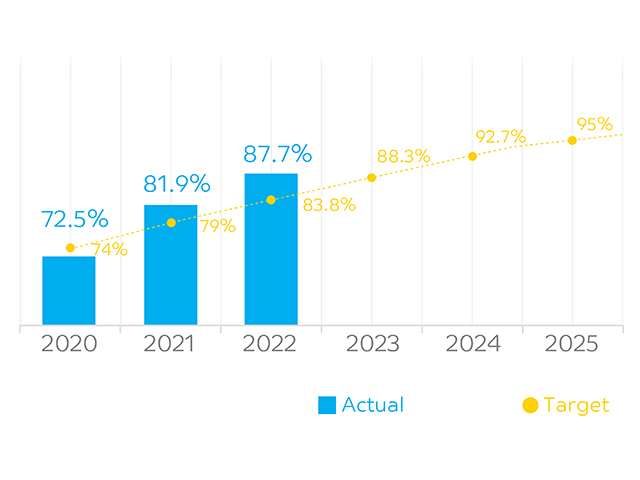
EHSS COMPETENCY DEVELOPMENT
ENVIRONMENTAL
Environmental competency-development programs are critical to maintain the right balance of knowledge within each organization and to ensure new recruits receive specific environmental knowledge required in their jobs. The NEBOSH Certificate in Environmental Management training provides knowledge of managing environmental risk, environmental legislation, environmental hazards, and key features of an Environmental Management System (EMS).
In 2022, we successfully conducted two training programs on NEBOSH certificate in Environmental Management for 25 participants as a part of the EHSS strategy execution on human-capital development at our affiliates in Saudi Arabia.
PROCESS SAFETY
Global Process Risk Management (PRM) continued to build process-safety competency across the entire organization in 2022 by developing and offering relevant process-safety qualifications and training programs. Each program is incorporated within the SABIC Process Safety Competency Framework, and follows the continuous improvement approach to both content and delivery.
Process-safety competency needs are also integrated into the Operation Management System (OMS) training matrix, focusing on ensuring the continuity of key process safety programs. These include:
– Continuing to work with the Mary Kay O’Conner Process Safety Center to develop process-safety professionals. In 2022, 26 engineers completed Developing Level Batch 5 and continued to the Proficient Level (Batch 1); in 2023, the goal is to continue conducting Developing Level Batches 6 and 7.
– Process-Hazard Analysis (PHA) quality improvement through the PHA Leader Qualification program; by the end of 2022, 48 candidates completed PHA Leader-Qualification Module 3 (another 10 candidates are expected to be certified in early 2023). As per the 5-year strategy plan, it is expected to have six (small site) and nine (large site) SABIC PHA-qualified leaders at each site.
– Sustaining the delivery of Foundations of Process Safety (FoPS) training with 114 trainees in 4 sessions.
– Initiating new learning interventions through 19 training sessions globally in writing effective operation and maintenance procedures; each session was opened by a SABIC site leader, and was attended by 407 SABIC employees overall.
– Developing and conducting Management of Change and Pre-Startup Safety Review training for 98 SABIC employees.
– Awarding emergency-response certification for 117 SABIC employees.
– Delivering Explosion Risk Assessment & Protection at the Workplace by PRM SME for 58 SABIC employees.
– Conducting advanced training on Consequence Modeling & Facility Siting for 14 process-safety and fire-prevention engineers.
INDUSTRIAL HYGIENE
In 2022, the Middle East and Africa (MEA) region enrolled 14 candidates across 3 BOHS modules; 10 candidates successfully passed their assigned modules, thus achieving a pass rate of 71%. Four candidates successfully completed all seven modules and were eligible to earn the ultimate BOHS (iCertOH) certification of competency in industrial hygiene after fulfilling the requirements of the BOHS Board of Examinations.
OCCUPATIONAL SAFETY
In 2022, 13 candidates successfully earned the NEBOSH Diploma while 45 earned the NEBOSH International General Certificate in Occupational Health and Safety. Meanwhile, 15 candidates enrolled in the NEBOSH Course in Saudi Arabia and another 15 earned the NEBOSH AMR.
This year, SABIC conducted SHEM Standard Training sessions for the newly circulated SHEMs (SHEM 05, 15, 08, 12, 10 & 02.02). These newly circulated SHEMs are revisions made to existing documents, and the training sessions on the aforementioned revised content were conducted globally (either in-person or virtually) across the regions. Confined Space Entry Training constructed confined-space simulator training units and held training scenarios in Jubail and Yanbu for the simulator project that included a training package and site selection. The company also held multiple three-hour workshops to improve leadership engagement effectiveness and visibility in a push to promote awareness, rule adherence, and hazard recognition based on SHEM-08.01 new requirements across all sites.
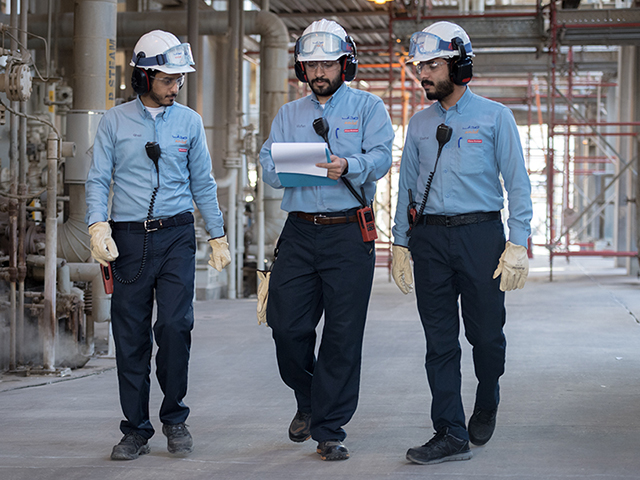
We meet regulatory and contractual requirements through periodic auditing.
SECURITY
In 2022, the Security Center of Excellence rolled out an updated SRA tool for small sites. The tool provided a process to identify a facility’s critical assets and assign mitigation strategies to secure them. The Center of Excellence also updated the process to measure the state of a facility’s security systems such as its CCTV systems, lighting, access controls, and other controls. It will help sites to identify any gaps in security-equipment functionality and deploy alternate mitigation measures to address any arising issues.

Confined-space simulator
EHSS RATE METRICS AND ANALYSIS
| Dimensions (Unit) |
|
2018 | 2019 | 2020 | 2021 | 2022 |
|---|---|---|---|---|---|---|
| Fatalities | 0* | 0* | 3* | 0* | 0* | |
| Fatalities rate (Fatalities/200,000 hours worked)2 | 0.000 | 0.000 | 0.000 | 0.000 | 0.000 | |
| EHSS rate (Incidents/200,000 hours worked) | 0.43* | 0.57* | 0.42* | 0.34* | 0.34* | |
| Total recordable incident rate (Incidents/200,000 hours worked)2 | 0.14* | 0.14* | 0.10* | 0.11* | 0.10* | |
| Occupational illness rate (Illnesses/200,000 hours worked)2 | 0.003* | 0.008* | 0.003* | 0.002* | 0.001* | |
| API 754 PSE Tier 1 (Incidents) | 7 | 25 | 10* | 15* | 11*1 | |
| API 754 PSE Tier 2 (Incidents) | - | - | 13 | 6 | 81 | |
| Security incidents (Class A + Class B + Class C: SHEM-10) | 1 | 1 | 1 | 1 | 2 | |
| Security Incident Rate (Incidents/200,000 hours worked) | 0.001 | 0.001 | 0.001 | 0.001* | 0.002* | |
| Hazardous substances released (t) | - | - | 14.3* | 2.8* | 6.8* | |
| EHSS Maturity Index (%) | - | - | 72.5 | 81.9 | 87.7 |
*Assured by KPMG
1. API 754 3rd Edition
2. Fatalities, total recordable incident rate and illness rate have been split for direct hire and leased-contractor employees and outsourced-contractor employees.
EHSS PERFORMANCE
We monitor EHSS performance metrics to study a comprehensive range of incident types and improve performance. These incidents include environmental releases, process-safety loss of primary containment events, occupational health, safety injuries, illnesses, and security incidents. Although it has grown more difficult to find improvement opportunities as we progress, we strive to continually understand the underlying causes of incidents, comprehend their behavioral aspects, and identify any resulting near-misses. The objective is to reduce repeating incidents (i.e., any incidents that occurred in the past with similar root causes). We deploy IT enablers and initiate digitization initiatives to optimize EHSS performance data quality and efficiency. Our EHSS performance monitoring is built into the EHSS Management System and updated with the latest international best practices and standards.
This year, our process safety team revised our incident management procedure (SHEM-10) to implement the 3rd edition of API-754 in order to align with the International Process Safety Standard API-754.
– The EHSS rate - the main indicator of our EHSS performance - improved by 90% from 2005 to 2022, and will stabilize this year on 0.34. Having identified injury incidents as the biggest major SHER-contributing incident type with a behavior-based root cause (based on last year’s incidents analysis), we introduced the Human Failure Model to gain clarity and insights about the underlying reasons for human failures in order to define better control measures that improve SABIC’s EHSS Performance.
– Two Security Class C incidents affected the otherwise stable Security Incident Rate (SIR), lowly contributing (<1%) to the overall EHSS Rate.
– API 754 Tier 1 Process Safety Events improved (from 15 in 2021 to 11 in 2022).
EHSS RATE*

– In 2022, the occupational illness rate for outsourced contractor employees was relatively stable with low contribution (<1%) to the overall EHSS Rate despite two recorded illnesses. In 2022, the direct hire & leased contractor employee illness rate improved by 37% compared to 2021.
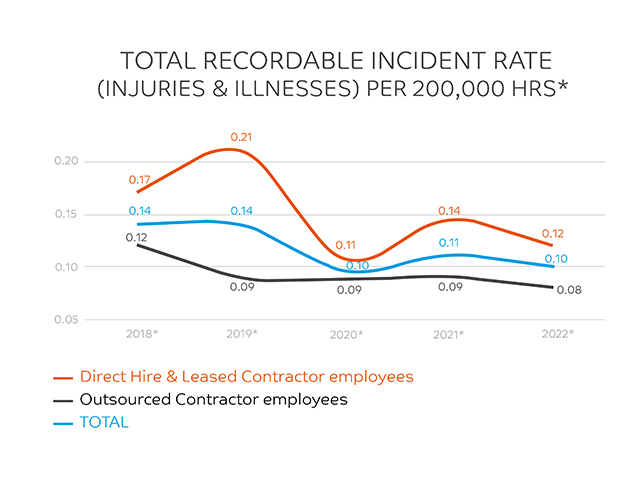
– The total recordable incident rate (TRIR) improved for direct hire & leased contractor employees owing to lower recordable injury and illness cases in 2022. The total recordable injury and illness cases improved by 10% (91 cases in 2022 versus 101 in 2021). Meanwhile, the outsourced contractor employees and SABIC TRIR were respectively 11% and 9% compared to 2021.
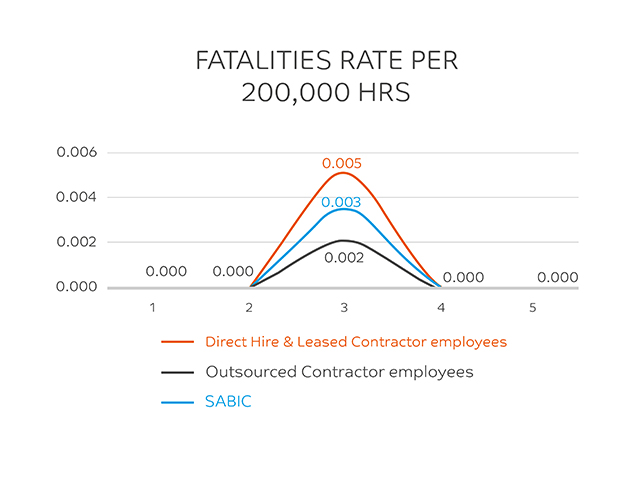
– No fatalities were recorded in 2022
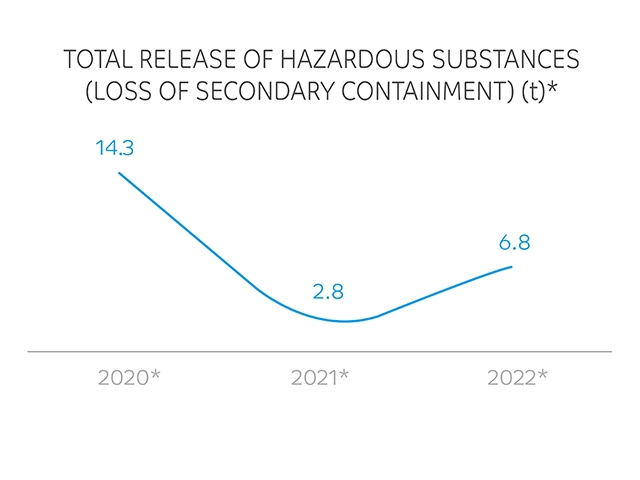
– Our 2022, total loss of secondary containment hazardous chemicals released increased by 143% compared to 2021, mainly caused by one Process Safety Loss of Primary Containment (LOPC) Incident (ethylene released to atmosphere) that contributed 73% toward the total 2022 release quantity.
EHSS INITIATIVES IN 2022
Regional initiatives
We conducted several regional EHSS initiatives in 2022 to increase employee and contractor awareness and participation across the globe. These included:
- The Inaugural Greater China Safety Day Campaign held across the Greater China region, where over 300 employees online and over 600 employees onsite actively participated in the campaign to promote EHSS awareness. Conducted under the theme “Connect With Right Mindset, Protect With Right Behaviors”, the initiative consisted of various engaging activities and a grand live virtual event, and resulted in over 570 posters and over 1,000 views by employees.
– The Inaugural Rest of Asia (RoA) Regional Safety Day Campaign, a week-long campaign with over 400 employees participating in the initiative to increase awareness of SABIC’s Basic Safety Behaviors and promote a strong safety culture and mindset.
In addition, our WE CHOOSE SAFETY™ initiative emphasizes our active engagement in safety at work and in our personal lives. In 2022, WE CHOOSE SAFETY™ introduced the Terrible Three to help in recognizing and preventing the hazards that cause incidents in the Americas region: Slips, Trips & Falls; Line of Fire; and LOTO. Many SABIC employees participated in WE CHOOSE SAFETY ™ webinars led by the SABIC leadership, taking part in the ‘Slips, Trips and Falls’ webinars as the mobile trailer travelled around to different sites for training purposes. Employees also had the opportunity to take a virtual visit to the Burkville site through a LOTO-enhanced reality environment that allowed them to partake in LOTO simulations and engage with colleagues about identifying and removing risks.
Contractor Safety Program
SABIC’s Third Party Management System ensures that the process of selecting and managing third parties (engaged in a legal contract for providing or purchasing materials and services) is conducted in an EHSS responsible manner that is consistent with SABIC’s EHSS objectives. To this effect, SABIC’s approach is to partner with our contractors so they can deliver the expected results while fulfilling EHSS regulations with full compliance with our EHSS Life Saving Rules (LSR).
A part of the program’s goals is centered on Supplier Due Diligence, allowing SABIC to achieve consistent validations of supplier compliance levels against a range of criteria, including SHEM, Responsible Care 14001 requirements, and SABIC Supplier Code of Conduct.
In 2022, SABIC focused on identifying areas designed to develop and improve our Contractor Safety Program, including:
– Third Party Improvement – Contractor digitization initiatives (field auditing with handheld devices, integrated contractor forklift assessments, and contractor dashboard with push notifications on performance).
– Supplier EHSS Qualification – implementing new Global SABIC SLM System (SAP ARIBA).
– Enhanced Metrics and Reporting – Additional third-party transportation KPIs.
CONTRACTOR PERFORMANCE EVALUATION TOOL
The Power BI performance evaluation tool was used at the Burkville site to input field EHSS observations and conduct field safety audits and will be rolled out at other facilities as well. The tool is a powerful digital handheld platform that enables consistency and data reporting and analytics, allowing observers to gather data in the field with better consistency and effectively, thereby reducing time spent both in the field and in duplicating work in transcribing on to spreadsheets. It also provides company representatives with full reporting capability as well as a real-time dashboard and complaint inventory.
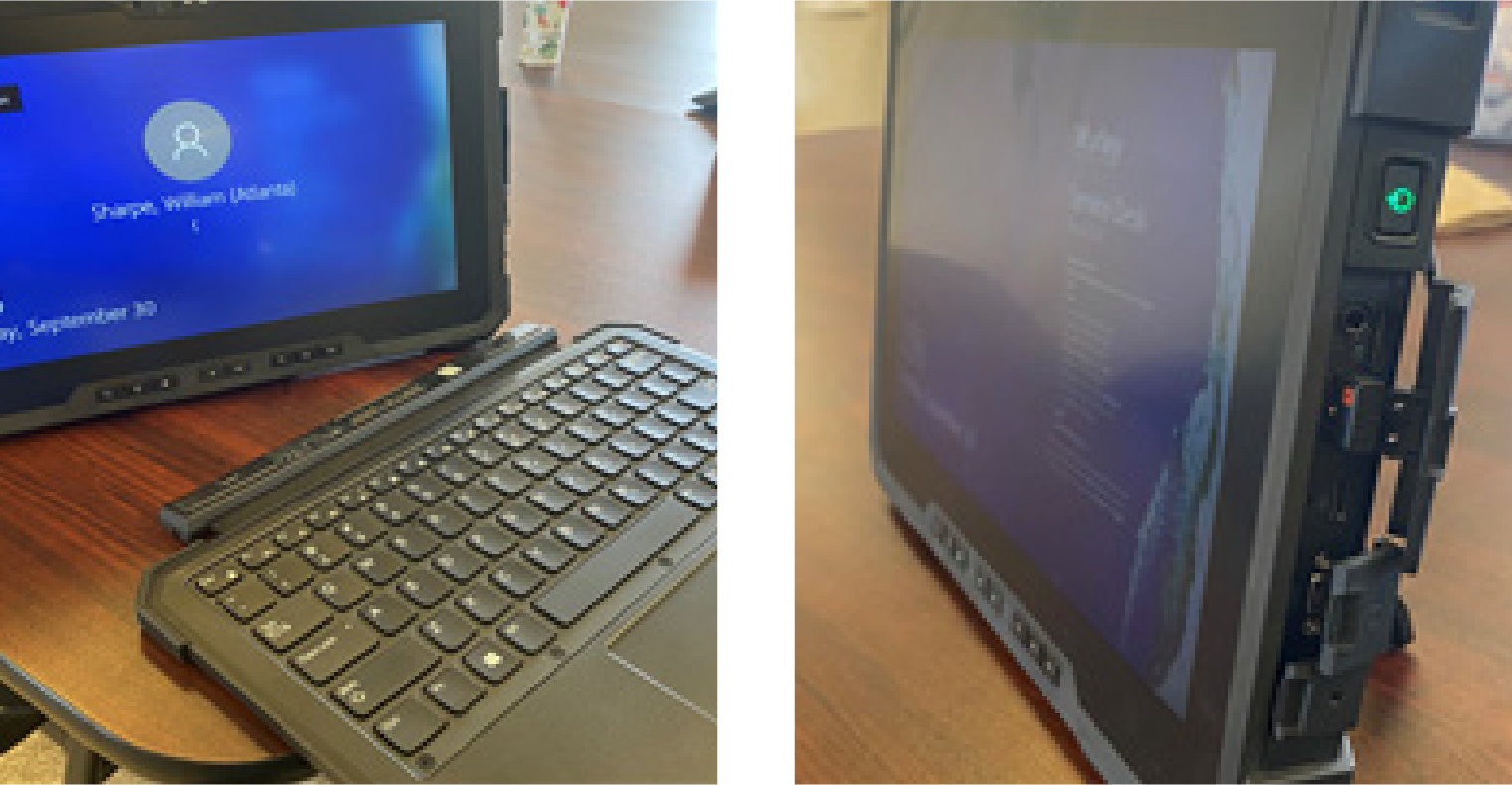
Digitization Enablement
SABIC’s Cooperate Digitalization program and Global EHSS worked on several EHSS initiatives to enhance the EHSS performance and decision support. This included the deployment of electronic safe work permits in several plants to drive the effective implementation of related management systems with high compliance and visibility. Other initiatives such as leveraging Artificial Intelligence (AI) to forecast environment emissions are designed to help adopt a proactive action stance that will help SABIC to avoid exceeding emission limits.
In addition, SABIC continued its efforts to enhance the deployment of Energy Isolation (LOTO) for higher risk non-routine activities. We conducted extensive field verification assessments at six sites and these assessment learnings were shared with all global sites for implementation.
EHSS Engagement
In October 2022, SABIC participated in the fifth Saudi International Conference on Occupational Safety and Health. The pavilion showcased the SABIC competency improvement journey through SERA and EHSS programs - where visitors were exposed to SABIC's experience in developing capabilities - as well as virtual simulations of working at high altitudes, identifying and managing workplace hazards and home safety hazards, and emphasizing the importance of safety everywhere from home to the workplace. SABIC also participated in many panel discussions that tackled important OSH-related topics.

SABIC showcases its experience in developing capabilities in occupational safety and health.
To promote effective process safety networking at a global level, SABIC PRM sponsored several regional process safety conferences and actively participated in the GPCA newly formed process safety network. PRM also actively participated in technical meetings of the European Process Safety Centre (EPSC) and contributed to the 2022 CCPS Middle East Process Safety Conference. SABIC participated in several workshops and meetings with the Ministry of Energy and Ministry of Environment, Water and Agriculture in Saudi Arabia to negotiate challenges that industries would face when implementing the new MEWA Environmental Regulation.
As a member of the AICM in the Asia Pacific (APAC) region, SABIC joined in the regular workshops organized by AICM, and participated in different external EHSS seminars, conferences, and workshops to actively learn and understand EHSS regulation trends. We also took part in similar interactions across other regions like Europe (via CEFIC and Plastics Europe) and the United States (via ACC). Furthermore, SABIC immediately started working with the Plastics Europe Taskforce set up to develop an Operation Clean Sweep (OCS) thirdparty certification standard when the latter made the announcement. Over the last 2–3 years, we have actively participated in agreeing with the principles and drafting the content of the standard.
SABIC is also closely following up on the developments around the Global Plastic Treaty through its business associations, ensuring our strategy on this field is aligned and fit for its purpose.
